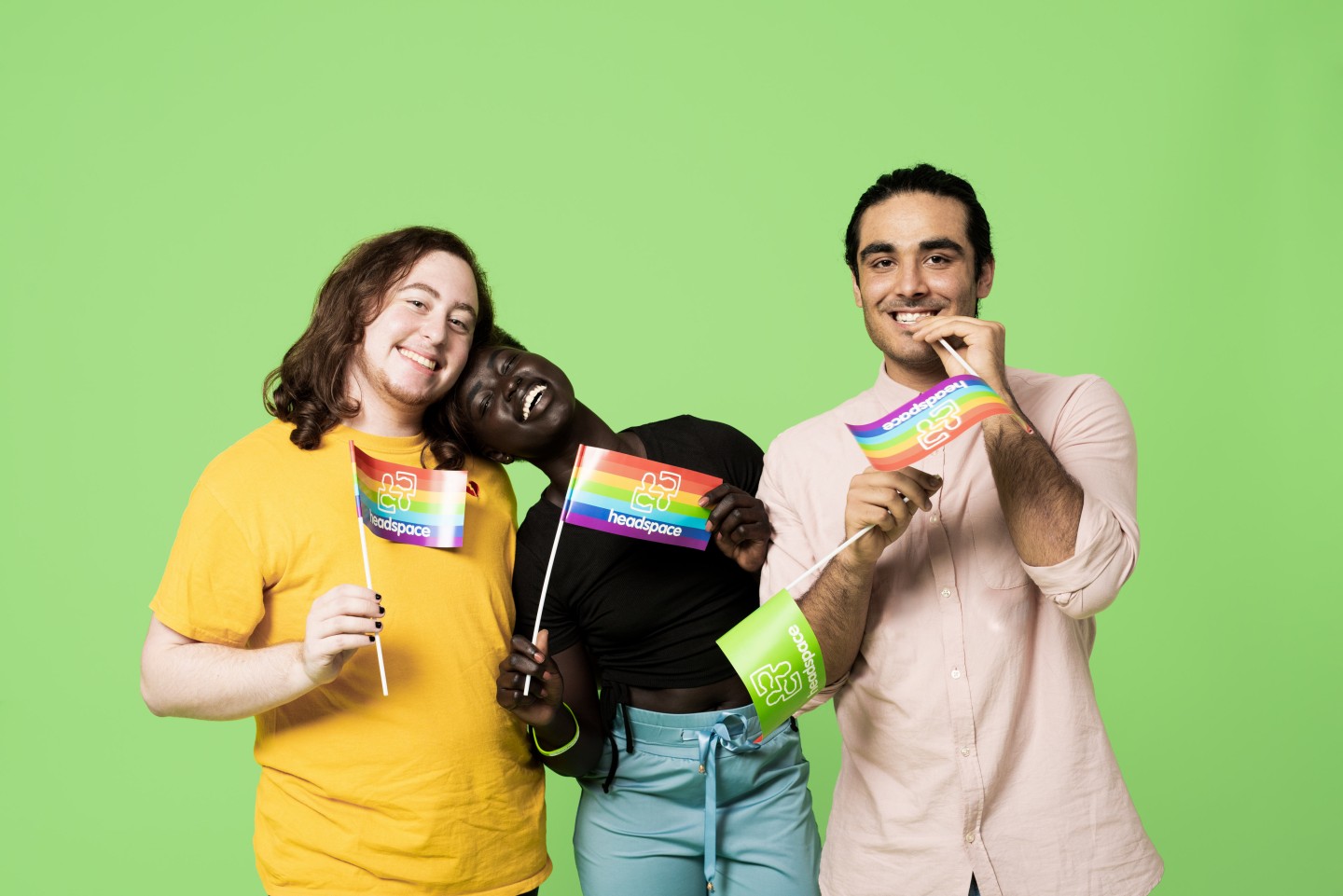For LGBTIQA+ young people, this journey comes with unique considerations. You might have questions like: “How can I spot if an employer truly values inclusion? Should I disclose my identity - and when?”
This guide offers practical strategies to help you identify inclusive and supportive workplaces, so you can feel confident in your job search and career journey.
Many LGBTIQA+ young people may hold intersecting identities, such as being First Nations, neurodivergent, multicultural, or living with a disability. These experiences can further shape how you navigate employment.
What's covered in this guide?
Note, the examples and flags used in this guide aren’t about “good” or “bad” workplaces. These signs are here to support your decision-making, not to tell you where you should or shouldn’t work. When we talk about yellow flags, we are identifying things to be mindful of, or that might be worth investigating further. One yellow flag on its own doesn’t necessarily mean a workplace isn’t supportive - it’s about looking at the bigger picture and trusting your instincts.
1. Online presence and public statements
Many companies openly share their stance on diversity and inclusion. Here’s what to look for:
- Dedicated diversity statements: Explore a company’s About Us or Careers page for specific commitments to LGBTIQA+ inclusion. Job ads can also provide insights on this. For example, some employers highlight their stance on diversity and equity within their recruitment materials.
- Social media engagement: Look at whether they celebrate days like IDAHOBIT, Wear It Purple Day, and Pride Month.
- Leadership representation: Check who holds management roles - is there diversity among the people leading and representing the workplace? Inclusive workplaces ensure representation at all levels, not just entry positions.
- Engaging with external LGBTIQA+ organisations: A Rainbow Tick Accreditation or partnerships with LGBTIQA+ organisations like Minus18 can signal a genuine commitment to inclusion.
- Employee reviews: Websites like Glassdoor and SEEK can offer helpful, firsthand glimpses into what it's like to work at a company. However, it's important to keep in mind that reviews on these sites often reflect extreme experiences - either highly positive or very negative. Company culture may also change over time, and more recent reviews might be a better representation of what the company is like. While they can offer useful perspectives, they should be just one of many tools used to research a potential employer.
If you can’t find enough information online, consider reaching out to someone in the organisation to enquire about their workplace culture (e.g., via LinkedIn). You could also email the organisation’s human resources team to ask questions such as whether they have gender affirmation leave, or what the organisation’s diversity and inclusion policy is.
The Rainbow Tick is a national accreditation that helps organisations demonstrate they are safe, inclusive, and affirming for LGBTIQA+ people. It covers key areas like workplace culture, policies, and staff training.
To check if an organisation has Rainbow Tick accreditation, visit their website or look for mentions in their diversity statements. You can also explore the Rainbow Tick guide to understand what it means and how it supports LGBTIQA+ inclusion.
2. In the workplace environment
If you're visiting a workplace or interviewing for a position/role, pay attention to physical and cultural indicators of inclusion:
- Visible support: Do they display pride stickers, Rainbow Tick accreditation, or acknowledge LGBTIQA+ identities?
- Inclusive language: Pay attention to how staff interact. Do they avoid gendered assumptions and use inclusive language when addressing colleagues and customers?
- Community reputation: Check in with LGBTIQA+ networks or peers for insights into a company’s inclusiveness.
- Visible representation: Look for information shared by employees, like listing diverse pronouns (beyond he/him or she/her on platforms such as LinkedIn. Representation at different levels can signal a workplace that genuinely supports inclusion.
- Representation of other identities: Are there First Nations flags or artwork, multilingual resources, or inclusive signage on their website or on-site? Visible displays like this can indicate can signal a workplace’s commitment to cultural safety and diversity, and being welcoming and respectful of all backgrounds.
- Internal culture cues: Small but meaningful details, like staff wearing rainbow lanyards, ally badges, or participating in visible support initiatives, can reflect an environment where diversity is embraced, not just acknowledged.
3. Policies and practices
Review a company’s workplace policies to gauge their approach to inclusion:
- Having clear guidelines against harassment: Employers should have zero-tolerance discrimination policies.
- LGBTIQA+ staff networks: Internal support groups can signal long-term commitment.
- Inclusive benefits: Gender-neutral parental leave or other inclusive workplace benefits.
- Respect for identities: Observe whether the company respects chosen names and pronouns, this could be reflective of how they respond if you share yours.
- Inclusion training is required: If LGBTIQA+ inclusion training is mandatory for all staff, that’s a good sign.
Yellow flags – things to be mindful of
There’s no perfect formula for spotting a supportive workplace, but there are a few signs that might suggest a company still has room to grow in their commitment to inclusion. For example:
- If there’s little or no mention of LGBTIQA+ inclusion in their public materials (websites, social media, job ads), it may be worth looking deeper.
- If displays of support feel performative or not genuine. For example, they might post during Pride Month but not show ongoing efforts to support inclusion throughout the year.
- If diversity and inclusion topics are avoided or not addressed when raised, it could be a sign to ask more questions.
In summary, when looking for inclusive workplaces, you can:
- Check their online presence for diversity statements, leadership representation, and social media engagement with Pride events.
- Look for affiliations and visible support like Rainbow Tick accreditations, partnerships with LGBTIQA+ organisations, pride flags, inclusive signage
- Review employee feedback on platforms like Glassdoor or SEEK, but use cautiously.
- Observe workplace culture during visits or interviews - look for visible signs of inclusion and inclusive language.
- Assess policies and practices such as anti-discrimination policies, inclusive benefits, and staff training, if available.
Wording in Job Ads and Recruitment Paperwork
Before applying for jobs, it’s worth taking some time to assess whether a company genuinely values diversity and inclusion. A few simple checks can give you insight into a workplace’s culture and values, such as:
Green flags of an inclusive workplace
- Inclusive options for personal details: Forms that offer spaces for chosen names, include gender options beyond ‘male’ and ‘female’, allow you to self-describe, or separate legal name from chosen name.
- Gender-neutral language: Job ads and descriptions that avoid gendered terms like “he/she” and instead use “they.”
- Pronoun inclusion: Applications that ask for your pronouns (optionally) or recruiters who include their pronouns in email signatures.
- Encouraging diversity: Statements inviting diverse candidates to apply or highlighting LGBTIQA+ support networks.
Yellow flags – things to be mindful of
- Limited gender options: Forms that only allow “male” or “female” without flexibility or other options available, i.e.- “non-binary” or “sistergirl”.
- Buzzword-heavy or vague language: Companies that mention values like “diversity” or “inclusion” but don’t give any clear examples of how they put those values into practice.
- Questions that feel too personal: Requests for information on sexual orientation or gender identity without a clear reason as to why this data is collected - especially if mandatory.
- Outdated terms: Language like “homosexual” instead of “LGBTIQA+” may suggest a lack of awareness.
Consider the context
Some job applications or workplaces may request details related to gender or legal names for operational or legal reasons. While this can sometimes feel uncomfortable, knowing your rights and options can help you make informed choices.
- Certain roles or job requirements (e.g, security positions, Police Checks, or Working with Children’s Checks) may require legal names for identification and compliance purposes.
- Some questions about gender or sex might relate to insurance or workplace policies. A supportive employer should be able to clearly explain why this information is necessary.
- Some organisations collect demographic information to ascertain their numbers of diverse employees in a genuine attempt to be inclusive.
- Opt-out options - Some applications allow you to withhold personal details like pronouns or identity markers if you don’t feel comfortable disclosing them.
- Clarify when unsure - If you’re asked for personal information, it’s okay to ask why it’s needed and how it will be used. A workplace committed to inclusivity should welcome respectful questions.
Navigating these situations can feel tricky, but understanding the purpose behind certain requests can help you make decisions that feel right for you.
names and pronouns in the workplace
Your name and pronouns matter, and workplaces should respect them. If your legal name differs from your chosen name, here are some ways to navigate job applications and workplace interactions:
- Include both names - On applications, you can list your chosen name while providing your legal name where required (EG, for tax or security purposes).
- Clarify upfront - If you're hired, consider letting your employer know that your legal name will appear on official paperwork, but you would like to be called by your chosen name.
- Use pronouns - You can include your pronouns on your resume (EG, Jordan Smith (they/them)) or mention them during interviews. Some applications now offer optional sections for pronouns and chosen names.
In summary, things to look out for during recruitment and hiring process:
- Green flags include diversity statements, optional pronoun disclosure, and recruiters using their pronouns in communication.
- Yellow flags include limited gender options, outdated or vague diversity language, and invasive or mandatory personal questions.
- Understanding the context is important, as some legal or industry requirements may justify asking for certain personal details (e.g., for police checks).
disclosure of gender or sexual orientation in job applications
When applying for jobs, one question that might come up is whether to disclose your gender identity or sexual orientation. This is a personal decision, and there’s no right or wrong way to approach it, it’s about what feels best for you and your situation. Thinking through the benefits, considerations, and challenges can help you decide on the approach that feels the safest and most empowering for you.
things to consider when deciding to disclose
- The job and industry - Some roles require legal names for security or administrative purposes (EG, government or safety-sensitive industries), while others may offer more flexibility with chosen names and pronouns.
- Company culture - Research how the company approaches LGBTIQA+ inclusion. Check their diversity statements, employee reviews, and whether they have an established stance on inclusivity. If you're unsure, you can ask discreet questions like, “What kind of diversity training do you offer staff?”
- Your comfort level - Assess whether you feel safe and supported in sharing your identity. If you’re unsure, you can always wait and disclose later. Your decision isn’t final-it’s something you can revisit when the time feels right.
- Navigating identity and cultural expectations - Other parts of your identity, such as being First Nations, multicultural, or living with a disability, may carry the added responsibility of representing your culture and identity in multiple spaces. Consider how much emotional energy you’re willing, and able, to give in each space. It's okay to protect your wellbeing by choosing when, where, and how you show up in different parts of your identity. You don't owe full visibility to anyone.
A job search isn’t just about whether you fit a role, it’s also about whether the employer fits you.
- Pay attention to how you’re treated during recruitment. Are they inclusive and respectful of your identity?
- Some workplaces pair new hires with mentors or workplace buddies, which can help ease the transition into a diverse and supportive team.
- If something feels off, whether during interviews or interactions with staff, it’s okay to step back and look for opportunities that better align with your values.
Your identity is important, but it isn’t the only part of who you are. Your skills, passions, and goals matter, too.
- You don’t need to have everything figured out at once. Over time, you’ll find ways to advocate for yourself in a way that feels safe and empowering.
- Staying connected to LGBTIQA+ communities outside of work can help reinforce a strong sense of identity, especially if your workplace or location feels isolating.
- You can choose to share aspects of your identity, but you’re never obligated to.
- Protect your emotional wellbeing - set boundaries around what you feel comfortable discussing at work.
- If a workplace genuinely wants to learn and grow, engaging in conversations about inclusion can be meaningful. But the choice is always yours.
strategies for disclosure
If you decide to disclose your identity in the workplace, having a plan can help you feel more confident.
- Identify safe people - Consider who might be supportive, such as a manager, HR representative, or a peer who understands your experiences.
- Practice beforehand - Like preparing for an interview, rehearsing what you want to say can help you feel more prepared.
- Gauge their response - You could start with general questions about workplace diversity to see how they react before sharing personal details.
- Have a backup plan - If disclosure doesn’t go as expected, think about who you can turn to for support. You may also want to involve a trusted mentor or advocate when having sensitive conversations.
Your identity is valid, and you deserve a workplace where you feel comfortable being yourself.
Recognising what you can (and can’t) control
Discrimination or ignorance can happen in any workplace setting - from colleagues, customers, or even industry norms. While it can be frustrating, it’s not your responsibility to fix every issue.
- While the situation might feel personal, that isn’t always the case - Some people lack understanding, not because they mean harm, but because they haven’t learned yet.
- Prioritise your safety - Not every battle is worth the emotional toll. Deciding when and how to engage is your right.
- Know when to walk away - If a workplace feels unsafe or doesn’t align with your values, trust yourself to seek out an environment where you can thrive.
finding support
You’re not alone. There are resources to help you navigate workplace challenges:
- Know your rights - discrimination based on gender identity or sexual orientation is illegal in Australia.
- Seek community support - organisations like Minus18 offer helpful guidance.
- Connect with safe people - friends, family, elders, peers and mentors can offer advice and emotional support.
- Find workplace allies - Supportive colleagues can help create a safer and more inclusive work environment. Connecting with mentors or LGBTIQA+ staff networks can make a difference.
- Consider cultural factors - If you have a multicultural or First Nations background, finding spaces where people understand your experiences can be important. Seeking culturally safe networks inside or outside work can help you feel supported.
In summary:
- Disclosure is personal - There’s no right or wrong time; choose what feels safest and most empowering for you.
- Set clear boundaries - You’re never obligated to share personal details; protect your wellbeing and disclose only if and when it feels right.
- A disclosure plan can help - Identify safe people, rehearse what to say, and have a support plan in case things don't go well.
- Look for the right fit - Assess employers as much as they assess you; trust your instincts and walk away if a workplace feels unsafe or dismissive.
legal framework and protections
your right to privacy
You don’t have to disclose your gender or sexual identity unless it directly relates to the job. You have the right to ask why information is needed and how it will be used.
key legal protections
- Anti-discrimination laws: Employers cannot treat you unfairly based on identity.
- Equal opportunity: Fair access to jobs, promotions, and workplace benefits is a right.
- Bullying and harassment protections: Employers must take steps to prevent discrimination.
If you experience discrimination:
- Understand your rights - not everything unfair is considered unlawful discrimination, but support is available.
- Internal complaints - many workplaces have reporting mechanisms for concerns.
- External complaints - government bodies can help, but knowing the process beforehand is important.
- Unions - They can provide legal guidance and advocate for workplace rights if you need support.
- Seeking support - Trusted people or organisations can help you navigate workplace challenges and advocate for yourself with confidence.
In summary:
- You have a right to privacy - Disclosure of gender or sexual identity is not required unless directly relevant to the job; you can ask why the info is needed.
- Legal protections exist - Anti-discrimination laws, equal opportunity rights, and protections against bullying and harassment apply to all employees. Understanding the law helps you navigate and respond effectively.
- Support is available - Reach out to trusted people, unions, or LGBTIQA+ organisations for guidance and advocacy.
- Youth Law Australia - Provides legal advice on workplace rights and discrimination.
- Fair Work Ombudsman & state-based anti-discrimination bodies - Government resources for understanding and enforcing workplace protections.
- LGBTIQA+ Legal Services such as Q+ Law and LGBTI Legal Services
- Indigenous-led services - Some organisations provide culturally safe support for First Nations young people navigating employment and identity.
- Mob Strong Debt Help - Free nationwide legal advice and financial counselling service for Aboriginal and Torres Strait Islander people.
- Identified support options - If you prefer to speak with someone who understands your lived experience, look for services that offer identified staff.
- State specific First Nations Legal Services - head to the National Aboriginal and Torres Strait Islander Legal Service for more information on your local service.
- Community organisations - Some multicultural support networks provide employment guidance tailored to diverse backgrounds.
- Legal and visa support - If you’re an international student, check for services that offer workplace rights advice specific to visa holders.
If you're looking for mental health or wellbeing support tailored to the LGBTIQA+ community, the following services may be helpful:
- QLife - Free, anonymous LGBTIQA+ peer support and referral services.
- Employee Assistance Programs (EAPs) - Some workplaces offer free counselling and support services for staff.
- headspace - Provides mental health and employment support, including resources for trans and gender-diverse young people. You can explore more here.
- Fair Work Ombudsman - Role of Unions - Information on how unions advocate for workplace rights and protections
- National Debt Hotline - Information about finances and options for support, as well as Financial Counselling
- Moneysmart - Free tools, tips, and resources to help you take control of your finances.
Finding a safe and supportive workplace is more than just landing a job - it’s about working somewhere that respects and values you for who you are. By researching inclusive employers, understanding your rights, and considering when and how to disclose personal information, you can feel more confident in navigating the workforce. It’s a journey, and with the right strategies and support, you can build a career in an environment where you feel seen and respected.
If you’re unsure about where to start or need extra guidance, headspace is here to help.
For a glossary of terms used throughout this article, feel free to check out the Minus 18 and Australian Institute of Family Studies websites.
Get support with headspace Work & Study
If you're aged 15 – 25, headspace can help you navigate your career journey and develop the skills and confidence to reach your work or study goals.
headspace Work & Study programs are free to access online or in-person at over 50 of our headspace centres.
The headspace Content Reference Group oversee and approve clinical resources made available on this website.
Last reviewed September 2025.
Get professional support
If you feel you need help there are a range of ways we can support you.





